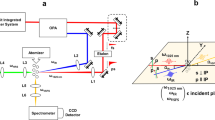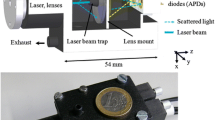Abstract
We apply to aerosols the optical method of Single Particle Extinction and Scattering recently proposed for characterizing liquid suspensions and specifically adapted to the aim. It provides simultaneous measurements of the real and imaginary parts of the field scattered in the forward direction by single airborne particles passing through a tightly focused laser beam. The intensity of transmitted light is collected in the forward direction, thus realizing a self-reference interferometric scheme relying on the fundamentals of the optical theorem. A high frequency (20 MS/s), extended dynamics (12 bits) sampling is performed by a cheap segmented photodiode, and a specific pulse shape analysis is exploited to validate the signals against a precise mathematical model. We show that accessing two independent physical quantities allows to exploit physical models to recover the aerosol size distribution from the measurement of the refractive index, either real or even complex. Laboratory measurements have been performed with polydisperse aerosols made of water droplets and NaCl in the submicron range, and the system has been accurately characterized. Examples of measurements of graphite nanoparticles and Pyrethrum smoke are shown. Limitations are discussed.












Similar content being viewed by others
References
Albani S, Mahowald NM, Perry AT, Scanza RA, Zender CS, Heavens NG, Maggi V, Kok JF, Otto-Bliesner BL (2014) Improved dust representation in the community atmosphere model. J Adv Model Earth Syst 6:541–570. doi:10.1002/2013MS000279
Andreae MO, Gelencsér A (2006) Black carbon or brown carbon? The nature of light-absorbing carbonaceous aerosols. Atmos Chem Phys 6:3131–3148
Bassini A, Menchise M, Musazzi S, Paganini E, Perini U (1997) Interferometric system for precise submicrometer particle sizing. Appl Opt 36:8121–8127
Batchelder JS, Taubenblatt MA (1989) Interferometric detection of forward scattered light from small particles. Appl Phys Lett 55:215–217
Bauer E, Ganopolski A (2014) Sensitivity simulations with direct shortwave radiative forcing by aeolian dust during glacial cycles. Clim Past 10:1333–1348
Bernardoni V, Valli G, Vecchi R (2017) Set-up of a multi wavelength polar photometer for off-line absorption coefficient measurements on 1-h resolved aerosol samples. J Aerosol Sci 107:84–93
Bohren CF, Huffmann DR (1983) Absorption and scattering by small particles. Wiley, New York
Chemyakin E, Burton S, Kolgotin A, Müller D, Hostetler C, Ferrare R (2016) Retrieval of aerosol parameters from multiwavelength lidar: investigation of the underlying inverse mathematical problem. Appl Opt 55:2188–2202
Chylek P, Grams GW, Pinninck RG (1976) Light scattering by irregular randomly oriented particles. Science 193:480–482
Cotterell MI, Mason BJ, Preston TC, Orr-Ewing AJ, Reid JP (2015) Optical extinction efficiency Measurements on fine and accumulation mode aerosol using single particle cavity ring-down spectroscopy. Phys Chem Chem Phys 17:15843–15856. doi:10.1039/C5CP00252D
Cotterell MI, Preston TC, Orr-Ewing AJ, Reid JP (2016) Assessing the accuracy of complex refractive index retrievals from single aerosol particle cavity ring-down spectroscopy. Aerosol Sci Technol 50:1077–1095. doi:10.1080/02786826.2016.1219691
David G, Esat K, Ritsch I, Signorell R (2016) Ultraviolet broadband light scattering for optically-trapped submicron-sized aerosol particles. Phys Chem Chem Phys 18:5477–5485
Harvey LDD (1988) Climatic impact of ice-age aerosols. Nature 334:333–334
Heim M, Mullins BJ, Umhauer H, Kasper G (2008) Performance evaluation of three optical counters with an efficient “multimodal” calibration method. J Aerosol Sci 39:1019–1031
IPCC, 2013: Climate Change 2013: The Physical Science Basis. Contribution of Working Group I to the Fifth Assessment Report of the Intergovernmental Panel on Climate Change [Stocker, T.F., D. Qin, G.-K. Plattner, M. Tignor, S.K. Allen, J. Boschung, A. Nauels, Y. Xia, V. Bex and P.M. Midgley (eds.)]. Cambridge University Press, Cambridge, United Kingdom and New York, NY, USA, 1535 pp, https://doi.org/10.1017/CBO9781107415324
Lack DA, Langridge JM (2013) On the attribution of black and brown carbon light absorption using the Ångström exponent. Atmos Chem Phys 13:10535–10543
Lambert F, Delmonte B, Petit JR, Bigler M, Kaufmann PR, Hutterli MA, Stocker TF, Ruth U, Steffensen JP, Maggi V (2008) Dust-climate couplings over the past 800,000 years from the EPICA Dome C ice core. Nature 452:616–619
Mishchenko MI, Hovenier JW, Travis LD (eds) (1999) Light scattering by nonspherical particles: theory, measurements, and applications. Academic Press, San Diego
Moosmüller H, Chakrabarty RK, Arnott WP (2009) Aerosol light absorption and its measurement: a review. J Quant Spectrosc Radiat Transf 110:844–878
Nakagawa M, Nakayama T, Sasago H, Ueda S, Venables DS, Matsumi Y (2016) Design and characterization of a novel single-particle polar nephelometer. Aerosol Sci Technol 50:392–404
Newton RG (1976) Optical theorem and beyond. Am J Phys 44:639–642
Potenza MA, Sabareesh KP, Carpineti M, Alaimo MD, Giglio M (2010) How to measure the optical thickness of scattering particles from the phase delay of scattered waves: application to turbid samples. Phys Rev Lett 105:193901
Potenza MAC, Milani P (2014) Free nanoparticle characterization by optical scattering field analysis: opportunities and perspectives. J Nanopart Res 16:2680
Potenza MAC, Sanvito T, Pullia A (2015b) Measuring the complex field scattered by single submicron particles. AIP Adv 5:117222
Potenza MAC, Sanvito T, Argentiere S, Cella C, Paroli B, Lenardi C, Milani P (2015a) Single particle optical extinction and scattering allows real time quantitative characterization of drug payload and degradation of polymeric nanoparticles. Sci Rep 5:18228
Potenza MAC, Sanvito T, Pullia A (2015c) Accurate sizing of ceria oxide nanoparticles in slurries by the analysis of the optical forward scattered field. J Nanopart Res 17:110
Potenza MAC, Albani S, Delmonte B, Villa S, Sanvito T, Paroli B, Pullia A, Baccolo G, Mahowald N, Maggi V (2016) Shape and size constraints on dust optical properties from the Dome C ice core, Antarctica. Sci Rep 6:28162
Ruth U (2002) Concentration and size distribution of microparticles in the NGRIP Ice Core (Central Greenland) during the last glacial period. PhD Dissertation at Department of Geosciences of the University of Bremen. Published as Report n. 428 of the Berichte zur Polar- und Meeresforschung (ISSN 1618-3193). Available at: http://www.ub.uni-heidelberg
Sachweh B, Umhauer H, Ebert F, Buttner H, Friehmelt R (1998) In situ optical particle counter with improved coincidence error correction for number concentrations up to 107 particles cm−3. J Aerosol Sci 29:1075–1086
Sanvito T, Zocca F, Pullia A, Potenza MAC (2013) A method for characterizing the stability of light sources. Opt Express 21:24630–24635
Seinfeld JH, Pandis SN (1998) Atmospheric chemistry and physics. From air pollution to climate change. Wiley, New York
Sorensen CM (2001) Light scattering by fractal aggregates: a review. Aerosol Sci Technol 35:648–687
Taubenblatt MA, Batchelder JS (1991) Measurement of the size and refractive index of a small particle using the complex forward-scattered electromagnetic field. Appl Opt 30:4972–4979
Utry N, Ajtai T, Filep Á, Dániel PM, Hoffer A, Bozoki Z, Szabó G (2013) Mass specific optical absorption coefficient of HULIS aerosol measured by a four-wavelength photoacoustic spectrometer at NIR, VIS and UV wavelengths. Atmos Environ 69:321–324
Van de Hulst HC (1981) Light scattering by small particles. Dover, New York
Vecchi R, Bernardoni V, Paganelli C, Valli G (2014) A filter-based light-absorption measurement with polar photometer: effects of sampling artefacts from organic carbon. J Aerosol Sci 70:15–25
Villa S, Sanvito T, Paroli B, Pullia A, Delmonte B, Potenza MAC (2016) Measuring shape and size of micrometric particles from the analysis of the forward scattered field. J Appl Phys 119:224901
Zarzana KJ, Cappa CD, Tolbert MA (2014) Sensitivity of aerosol refractive index retrievals using optical spectroscopy. Aerosol Sci Technol 48:1133–1144
Acknowledgements
We acknowledge Marzio Giglio for useful discussions, F. Cavaliere and D. Viganò of the Mechanical Workshop of the Physics Department for supporting the realization of the SPES instrumentation.
Author information
Authors and Affiliations
Corresponding author
Ethics declarations
Conflict of interest
The authors declare that they have no conflict of interest.
Rights and permissions
About this article
Cite this article
Mariani, F., Bernardoni, V., Riccobono, F. et al. Single Particle Extinction and Scattering allows novel optical characterization of aerosols. J Nanopart Res 19, 291 (2017). https://doi.org/10.1007/s11051-017-3995-3
Received:
Accepted:
Published:
DOI: https://doi.org/10.1007/s11051-017-3995-3




